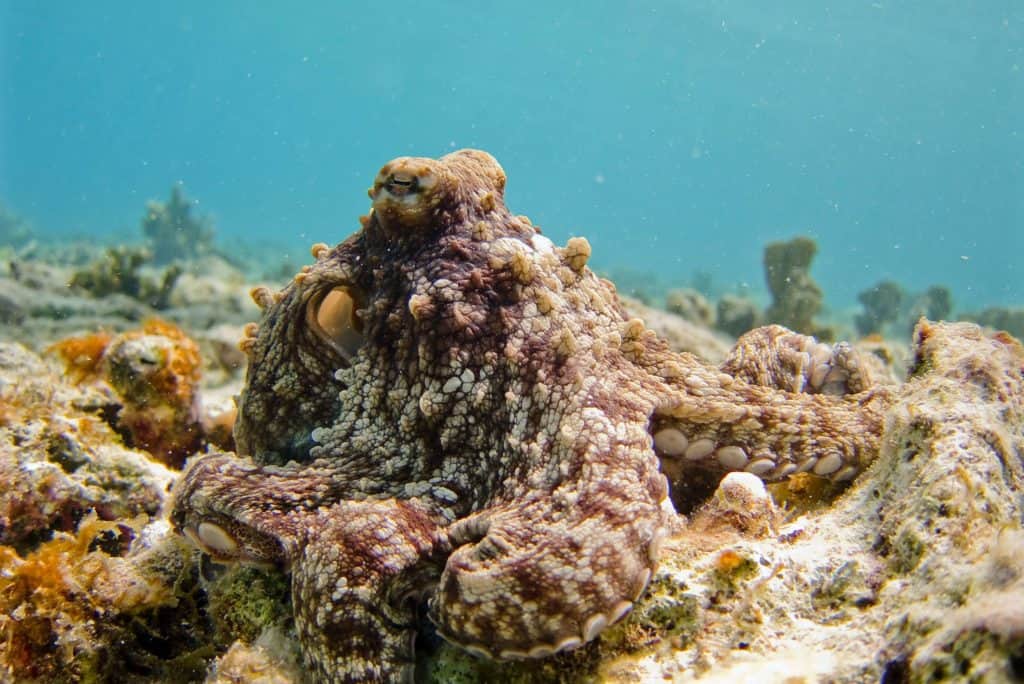Octopuses can often be found searching rock pools or shallow coastal waters looking for prey such as crabs, clams, sea snails, sea stars, and more.
All 300 species of octopus contain toxic venom which they inject into their prey, liquefying it before they begin to consume it.
The toxins work quickly to paralyze the prey, whilst their sucker-covered arms keep their prey firmly in their grasp, not providing any opportunity to escape.
Today, we’re going to answer a question that many of our readers are interested in when it comes to octopuses. How many stomachs does an octopus have?
Like we humans, octopuses only have one stomach. However, they have a crop that digests their meal beforehand. It goes out of the stomach and caecum and out the funnel to the anus.
Do Octopuses Have Stomachs?
Yes, octopuses have one single stomach that is similar to that of a human. They also have a crop to assist the stomach which digests the food beforehand.
From there, the food goes down to the caecum and out of the funnel. Their digestive tract is rather simple, but it’s also quite different from our circulatory system.
The meal is stored in the crop before being passed to the stomach for easier digestion before going to the caecum and out of the funnel.
This is why octopuses can eat surprisingly large prey for their size, as their crop does most of the hard work before the food reaches the stomach.
Octopus Digestive Process
All 300-plus species of octopus are venomous. They hunt by using the element of surprise through their camouflage ability, by taking their prey by surprise and injecting it with venom.
They have a parrot-like beak that they use to inject their prey with venom. Once injected, they lick it clean with their radula as the venom begins to break the food down so that the octopus can slurp it up.
Once ingested, the food makes its way up a short esophagus to the crop, where it is stored and further broken down by various enzymes.
In the crop, the food becomes like a milkshake as it gets broken down more before making its way to the stomach for digestion.
When the food is in the stomach and the octopus has begun to use it, the food makes its way to the caecum, which just like our bodies is the last stop before the anus.
All the food is then expelled through the funnel or siphon, and then the process repeats every time the octopus needs to eat.
What Do Octopuses Eat?
Octopuses feed on a variety of different food sources, including crabs, clams, snails, sea stars, and even other octopuses.
They are excellent hunters that usually hunt at night by injecting their prey with venom once in the tight grip of their sucker-lined arms.
Crabs, shrimp, and lobster rank among the favorite food of an octopus, they will do just about anything to get at these, even risking their lives.
Due to the octopus not having a skeletal system, they are able to squeeze into incredibly tight spaces.
Often times they risk their lives by squeezing into crab and lobster pots to steal the fishermen’s catch, before making their way out unscathed.
It’s a clear display of just how intelligent these animals really are, why hunt for food when you can leverage human lobster pots?
It makes complete sense and allows the octopus to maximize the amount of food they get without expending lots of energy.
Final Thoughts
How many stomachs does an octopus have? One, just like we humans. That said, they also have a crop that breaks down the food before it is passed to their stomach.
The crop is an incredibly important part of the octopus’s digestion process. It allows the octopus to be able to eat prey that is surprisingly large that they otherwise wouldn’t be able to without it.
Hopefully, you’ve enjoyed this post today and have learned something new about octopus stomachs and their digestion process.
Thanks for taking the time to read this post and feel free to share it with others who may find it of value.

Hi, I’m George – the founder of MarinePatch. I created this blog as marine wildlife has been my passion for many years. I’ve spent over a decade in the marine wildlife industry and spent years out in the field conducting research. In today’s modern world, an online blog is the best place for me to share my findings and reach as many people as possible to help educate and inspire others. Enjoy your time here and you’re welcome back anytime!

